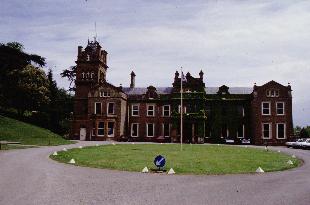 The gardens at the Hestercombe mansion combine both informal landscape vistas as well as formal gardens accented with numerous
water features. Now in the process of being restored, the original garden was designed by Coplestone Warre Bamfylde
between 1750 and 1786, and covers approximately 35 acres. A more formal Edwardian-style garden was designed as a
collaborative effort between Sir Edwin Lutyens and Gertrude Jekyll between 1904 and 1906.
The gardens at the Hestercombe mansion combine both informal landscape vistas as well as formal gardens accented with numerous
water features. Now in the process of being restored, the original garden was designed by Coplestone Warre Bamfylde
between 1750 and 1786, and covers approximately 35 acres. A more formal Edwardian-style garden was designed as a
collaborative effort between Sir Edwin Lutyens and Gertrude Jekyll between 1904 and 1906.
Leaving in the early morning from our lodging at the Homewood Park Hotel near the town of Bath, we traveled southwest
to Tauton to see Hestercombe, our first visit in a rather long day of garden tours. It was a chilly day, approiximately
45 degrees that morning with a strong wind out of the northwest. We were not due back to the hotel until 10:00 PM that
evening. Little did I know that I would be taking second morning "bath" at Hestercombe.
Our tour guide was a delightful lady, Mrs. Margaret Sharpley, who gave us an expert tour of the gardens punctuated with
clever stories and witty comments. I particularly enjoyed her stories of their disadvantaged swans, Eggbert and Cressida,
named by a local teenager who was fond of egg and cress sandwiches. She led us on a rather long walk past the recently
restored "Great Cascade" waterfall, through a garden in the style of 18th century plantsman William Robinson whose
concept was to let plants be themselves, to finally the more formal gardens designed by Gertrude Jekyll and Edwin
Lutyens. It was in the Edwardian Garden that I would take my bath.
At the start of our walk, we had seen the "Daisy Steps" above the main house at Hestercombe. The tall stone
columns beautifully framed the view of the mansion and gardens below, and the round terrace area had a large round stone in
the center to repeat the circular design.
We would see this pattern repeated in other parts of the garden. Entering through a
gate, we viewed a lovely walled herb garden that adjoined the Orangery, a protective hot house for raising citrus fruits.
Beyond the Orangery was the formal Edwardian Garden planted with numerous perennials. The stone walls were
adorned with clematis and wisteria vines in full bloom.
As I overlooked the Edwardian garden, I noticed a repeat design seen at the Daisy Steps, this time appreciating the
daisy-like flowers in full bloom between the steps. I decided to ascend to the top of the stairs to get a better view.
Snapping pictures while continuing to look trough my viewfinder, I kept stepping backwards trying to compose the
perfect view when suddenly my left foot no longer had any footing. I had just found a round reflecting pool, the
center feature of this terrace, and I subsequently fell backwards into the cold, cold water. Although only
about 3 feet deep, it was ample to get me completely soaked up to my neck, but I did hold my camera above water.
How kind the people at Hestercombe were, as well as all of my traveling companions! Knowing that it would be a
long, cold day to spend in wet clothes, everyone was concerned that I would catch pneumonia, and
I am very grateful for the kindness of so many people.
One of the members of our tour group, Cam Williams, bought me a dry, souvenir shirt.
Hestercombe's tour guide, Mrs. Sharpley, found me a pair of dry blue jeans donated by one of their gardeners. She even found
me an old windbreaker coat. The cooks at the restaurant were able to dry my sweater on top of their dish washer.
Because of the kindness of others I was once again in dry clothes, and I didn't
even come down with pneumonia. In fact, I was the only one on the trip
who didn't catch a cold. I guess the germs considered me a health risk.
|